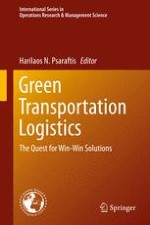2016 | OriginalPaper | Chapter
10. Being Green on Sulphur: Targets, Measures and Side-Effects
Authors : Christos A. Kontovas, George Panagakos, Harilaos N. Psaraftis, Eirini Stamatopoulou
Published in: Green Transportation Logistics
Publisher: Springer International Publishing
Activate our intelligent search to find suitable subject content or patents.
Select sections of text to find matching patents with Artificial Intelligence. powered by
Select sections of text to find additional relevant content using AI-assisted search. powered by
